EXCAVATED APOCRYPHA: THE ART OF ADRIAN WONG
| October 2, 2010 | Post In LEAP 5
Characterized by a reflective architecture of glass and steel and culturally dominated by a visually rich cinematic tradition that merges seamlessly with tourism marketing, Hong Kong does not lack for specular images of its urban core. In the now-classic films of Wong Kar-Wai and John Woo, the surface of the city emerges primarily through textural definition: the sweaty glint of neon on wet pavement, the contrast of floral patterned gowns against red lacquer furniture, the misty hillside just beyond the window. The collective body of the city, on the other hand, is presented through a constantly expanding archive of symbols that are attached to a restricted set of personae; that is to say, whereas the same group of some two dozen admittedly charismatic actors have dominated the silver screen for several decades, they have endured countless permutations through affiliation with a large number of talismanic props and other objects that construct the imagined community of literary Hong Kong as a myth of enduring cultural continuity. There are the small fishing boats in the typhoon shelters, the ferries, the electric trams, the qipao, Lion Rock, martial arts swords, southern barbecue, Cantonese opera masks, vampire teeth, paper sacrifices, triad cleavers, lanterns—the list is almost inexhaustible, and yet these features have come to stand in for the collective visual identity of Hong Kong in a way that no particular neighborhood, celebrity face, or architectural style could.
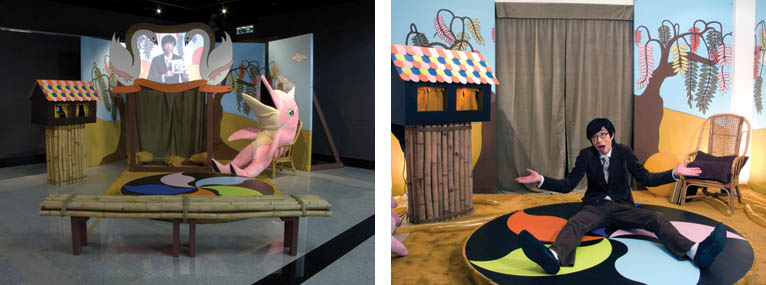
Adrian Wong absorbs and regurgitates these talismanic symbols in altered form, venturing often into filmic territory to borrow narratives, reconstruct dialogues, and build up surreal yet iconic settings. For Wong, however, the social value of such objects lies not as much with their representative qualities as with the possibilities for absurd story-telling and formal aesthetic features that they offer. The most significant aspect of his growing body of work is its willingness to play fast and loose with the hallowed if commonplace signifiers of culture and identity, loosening the binds between object and narrative, image and context in a way that contributes back to the parent culture even as it presents highly stylized and aestheticized (but never iconic) depictions of these visual styles to an imagined theatrical audience via a vaguely universal and totalizing sensibility. In some ways, Wong does for the quirky traditional street cultures of Hong Kong what the appropriation artists of postmodern painting and collage did for global trash culture, sincerely lending it new life by way of circulation throughout the well-lubricated channels of the international art world. Key to this process is the simultaneous production of both imagery writ large and images in the particular: in much of this work, the artist brings forth an understanding of the scene as a site for the manufacture of culture, providing needed if incoherent nourishment for the microcultures from which he draws raw contextual material. There is, for example, his large-scale installation Sang Yat Fai Lok (2008), which builds upon research into local television programs Calvin’s Corner, Children’s Corner, and Happy Birthday, all of which were shot between 1960 and 1975 but of which there are no remaining copies. After discovering family ties to host personality Calvin Wong Hay, Wong engaged in geneaological and televisual research into the programming of that time, employing family photographs, production stills, and newspaper archives to create a set containing a brightly colored puppet stage, midcentury furniture, nostalgic pastel wall images depicting trees, a larger-than-life-sized stuffed pink dolphin, and dried fish—among other things. Recording reconstructed episodes of the program on this set, a disconcertingly enthused Wong himself appears as the host in his own interpretation, leaving behind in documentation a series of photographs that negotiate an extinct visual culture into a position equally at home in the historical archives and in the contemporary art records of the present.
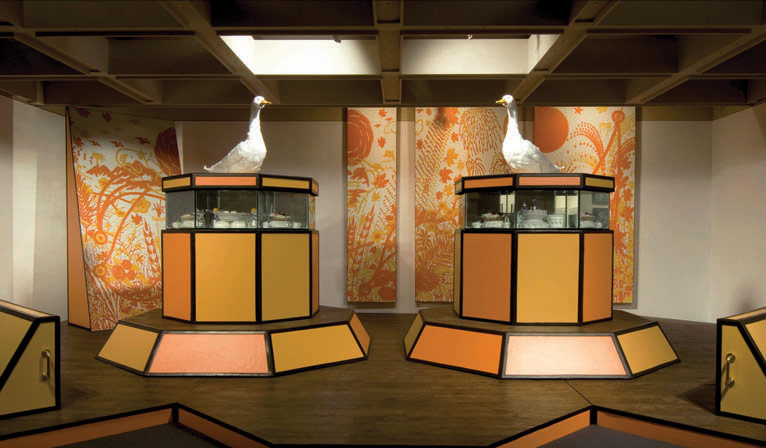
On the other hand, virtually all of his projects also involve still images that specifically and concretely offer objects for aesthetic appreciation as if they were sacrificial dioramas served upon the altar of the audience. In a stunt that made him infamous amongst the chattering classes of the Hong Kong media, Wong released a photograph of himself kissing a chicken around the height of the avian influenza scare in south China, attempting to push past the ingrained fears of impure biological life forms that sees an entire population reject its local sources of food at the slightest warning from above. Entitled Sak Gai (2007), this brief performance actually made use of a freshly slaughtered but not yet plucked chicken carcass rather than the trained, live bird he originally claimed; nevertheless, the photographic image continues to circulate today, particularly as an example of the alienation of contemporary art from social concerns. In terms of the status of the image, this project may be most significant for its reliance on the unchanging semblance of the digital photograph itself, which can be and often is easily separated from the conceptual narrative from which it originally emerged. Similarly, a recent project known as Bromide Series 1-4 (2010) involves photography of every food item consumed by the artist over the course of a single day, again interpellating the viewer as an accessory to the mythologies of Hong Kong through the predictable inclusion of comestibles like dim sum and cha chaan teng noodles alongside barbecued lamb chops and fresh vegetables. Posed in a highly artificial manner against a textured infinity wall of bold, slightly retro cloth prints, these perishable objects take on a life of their own exclusively through the composition of the image, gaining the consciousness of intersubjectivity through their newfound immanent ability to pose as portraits on the gallery wall.
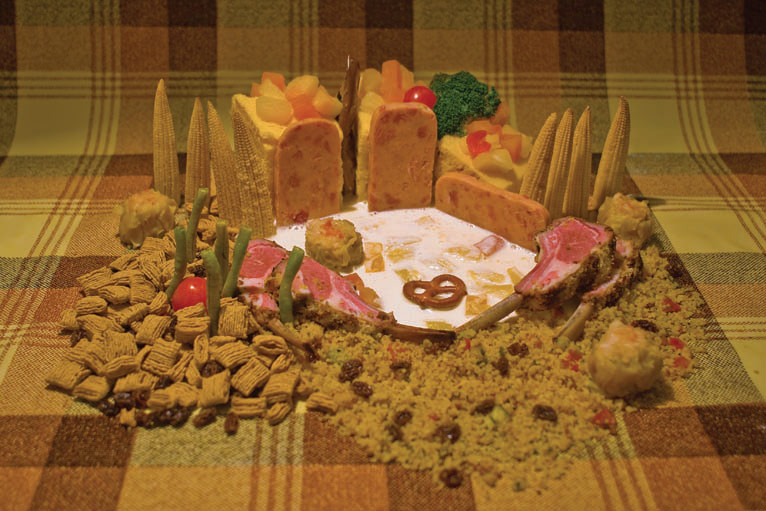
Almost uniquely within the artistic practices common throughout greater China, Adrian Wong develops many of these projects through a rigorous research-based methodology that draws from his academic background in child psychology, linguistics, and anthropology. Although never willing to divulge the abstractions of data and archival material in his final work, preferring to work through adapted techniques of craft and kitsch, Wong often spends months in preparation for major projects, carrying out interviews with involved figures and their descendants, reading through the existing literature, and delving into what filmic and textual archives exist in Hong Kong. Sang Yat Fai Lok clearly evinces such methods, as does the landmark installation From the Annals of the Harmony Jade Roast Meat Society (2009), a part of a broad research program with its own intrinsic historical value developed in conjunction with Word Asia Publishing House. Exhibited ostensibly on the occasion of the centenary of fictional film in Hong Kong, the project attempts to reconstruct the dialogue and contextual history of the first such movie, entitled Stealing a Roast Duck and directed by Liang Shaopo with the funding of Benjamin Brodsky and the cinematography of Roland Van Velzer. Ultimately taking the form of two animatronic ducks on a campy formica podium against a background of patterned panels derived from a popular style of locally produced paper cups, Wong’s interpretation offered a crass and by no measure comprehensive conversation revolving around certain aspects of the production of the film. According to legend and later anecdotal interviews, Roast Duck involved an intricate set of coded messages intended to facilitate the overthrow of the Qing regime in Beijing to be circulated through San Francisco and other revolutionary enclaves; such apocryphal notations here function as fertile ground for ruminations on ideas of cultural codes, transmission, and translation across both time as space. Appropriately, many of these always controversial claims have recently been proven false: the film was actually at least the fourth film produced by the team involved in the year 1914 alone, well after the last Qing emperor was deposed.
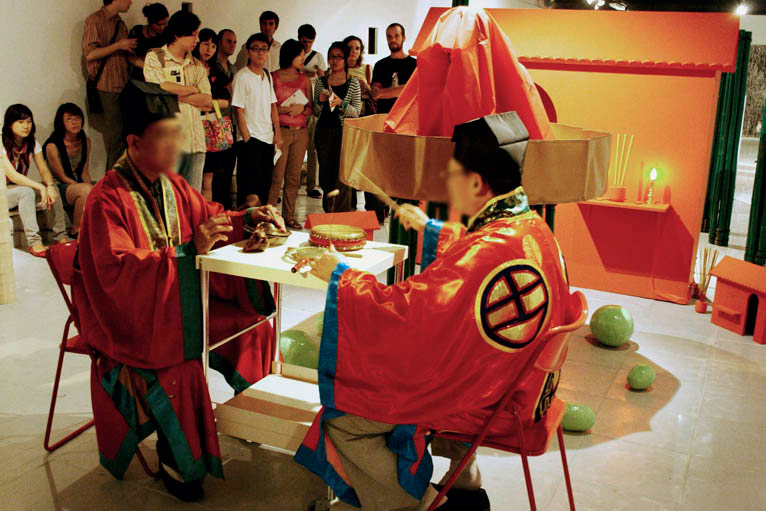
This process of the excavation of memory and archaeology of media artifacts surfaces again in Umbrellahead, I Will Find You (2010), a cooperative theatrical production that reached the stage only after groundbreaking research into the historical urban conditions of Western District in the earliest colonial settlements of Hong Kong. While interviewing residents of the area for a heritage-based project, Wong and his collaborators noted repeated reference to the story of a certain Lei Mei, a stunning actress who attained wide recognition and won many admirers locally before traveling to the West, entering a disastrously infelicitous marriage, and ultimately dying young in an asylum. As it happens, this entire story is an apocryphal didactic tale concocted by Chinese-language media in order to warn against the moral evils of profane Western ways; that a number of the elderly residents interviewed seemed to sincerely believe that this fictional character had married a cousin of a cousin or seduced a friend of an end could never be substantiated. Finding a certain pleasure in the tenacity of such beautiful memories, Wong transformed the tale into a surreal stage play in which objects like umbrellas, in reference to one of the last professional umbrella craftsman interviewed for the project, and the cases of musical instruments no longer existing since the Cultural Revolution, become characters in their own right. The exaggerated colors and architectural construction of the stage set once again provide a scene on which the specific images of these symbolic objects appear as detached apparitions of something lost to history but gained on behalf of both local memory and the vocabulary of forms within the international art world.
Another series of works, including Bless All Ye Who Enter Here (2007), Tuhng Gwai Wan (2007), and Seih (2005) circulates around a more personal experience of never-quitearchaic local culture that later expanded into a full-fledged investigation of the wider forces of economy and belief. Working out of an industrial studio widely understood to be haunted, Wong suffered a series of misfortunes ranging from the loss of personal belongings to massive and medically inexplicable internal bleeding that stopped as suddenly as it had begun, leading him to engage with the systems and rites of superstition in the popular mindset. Tuhng Gwai Wan collects, through an extensive research-based process, a tex tual list and explanation of various Taoist and other mystical rituals positioned alongside a table bearing all of the bizarre herbs, stones, and other physical materials involved in such events. Pushing the project to an extreme, Bless All Ye Who Enter Here invites Taoist priests to perform an exorcism to clarify the space. Throughout all this, Wong himself maintains an attitude of sympathetic disbelief, never sure if or when to give in to faith in the supernatural forces that manipulate the real estate market and other economic fields through hauntings and other uncanny events.
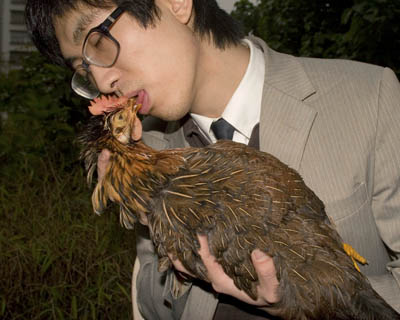
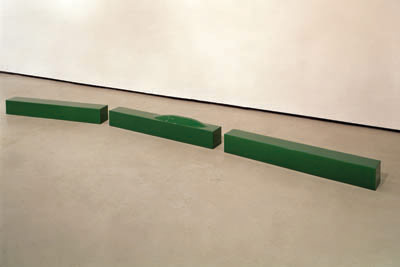
This particular project is culturally possible and even legible largely due to Wong’s personal identity, raised in the United States but maintaining a range of familial connections to Hong Kong. Far from indulging in the incoherence of such privileged identity politics, however, Wong tends to utilize this position as a passing outsider to his advantage, approaching with a certain sense of detachment forbidden territory that is typically spoken of in deadly seriousness or not at all, as with the exorcism of Bless All Ye Who Enter Here and the avian intimacy of Sak Gai. This position allows the artist to extract any notable aesthetic content from wider systems that he may not fully understand or trust, contributing to a sense of alienation from the activity depicted while bringing it into closer contact with his own training as a sculptor and psychologist. Many of the titles of these works consist of romanized Cantonese, a language with no definite alphabetic transliteration system of its own spoken only in the southern Chinese province of Guangdong, the regions of Hong Kong and Macau, and their respective diasporas abroad; this linguistic ambiguity, as confusing for readers of Chinese as for the totally uninitiated, tends to hold back a certain measure of explication that is then shifted to the position of the work itself. Haak Seh Wuih Tuhng Mau Jai (2007) is one such example, a short video of an obviously choreographed dance in which four shirtless, tattooed men delicately and occasionally violently dance with a small cat: in translation, the title should read “Triads with Kitten,” an absurd reframing of the gangster identity so easily stereotyped in Hong Kong cinema.
In other works, the professional assistance of the choreographer here is replaced by that of the acting coach, evincing an interest in the external experience of identity influenced by both the subjective portrayal of the self within a second-language society and the failure of objectivity in the psychoanalytical reading. Tuhng Ngoh Dei Wan(2007), for example, involves three pregnant mainland women illegally smuggled into Hong Kong and trained by a professional acting coach to act and respond in a manner as they themselves believed Mainland Chinese to be perceived by local Hong Kong Chinese. Seated at a small table, the women harass visitors to join their mahjong game, ridiculing and otherwise tormenting their gambling partners. Unfortunately, due to legal restrictions, no video of this performance exists, leaving the photograph once again to stand in as both evidence and representation of the work. Fitting the sartorial stereotypes of mainland visitors to Hong Kong and clutching mahjong tiles, the women depicted in these images both exist within and perform from the outside the identities to which they are assumed to belong. The notion of exaggerated behavior appears again with a new series of Affective Portraits (2010) in which acting coaches coax the subjects of the photographs to perform certain emotions. By relating particularly painful memories and via other rhetorical techniques, the affective positions of the posing subjects thus occasionally appear authentic to a greater or lesser degree, again projecting from the outside an identity or behavior that does not necessarily exist anywhere within the circumscribed space of the subject in terms of its own self-knowledge. Installed in threedimensional frames mimicking crystalline structures, these images are thus further disrupted in a way that underscores not the fragmentation of identity common to the postmodern mode but rather the always-already instability of the images on which this body of work so heavily relies.
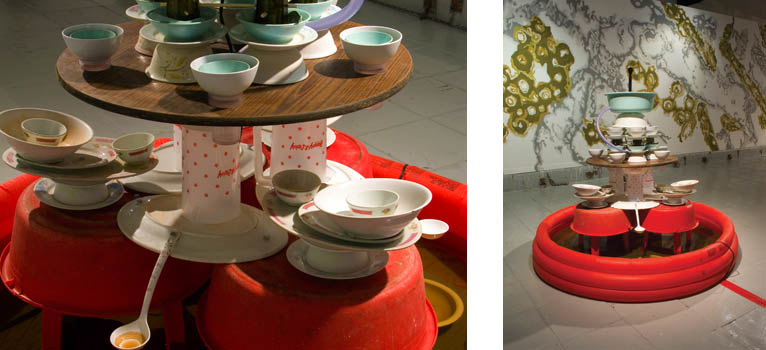
Although his artistic career began with a series of delightfully minimalistic and referential sculptures, in particular Boidae C. Constrictor (2005), which appears as a snake in three block-like sections, and I Love You But I Can’t Be With You (2005), which constructs highly formalist relationships between goldfish in round tanks, Wong has since tended towards excess in many respects. Minimalism, of course, is no ally of the theater, and it is the mode of live storytelling that emerges most successfully in these ornate and excessive productions and performances of research-based historical material. Narrative, however, is consigned to the position of an element of the scene, all in an effort to refine and process the totality of the story at hand into a set of images that, though never intended to stand in as iconic representations in their own right, nevertheless function as a symbolic currency contributed to discourses of art and contemporary culture. Most significantly, the roles played by history and identity are considerably tempered by a self-conscious humor that pervades much of this work, from the joking ducks of From the Annals of the Harmony Jade Roast Meat Society to Tunnel Vision (2008), a dramatization of the artist’s own colonoscopy, and Fountain (2006), a sculptural take on the ritualized practice of washing place settings in boiling dark tea before proceeding to eat at any meal. Ultimately, it is this comedic element—indubitably a strategy to cope with the play of multifold identities along the lines of the alienation produced by Cantonese transliteration—that positions Adrian Wong beyond the exclusive discourses of theater and neo-minimalism and in a cultural territory that sits at odds with both existing identity-based artistic practices in Hong Kong and formalist practices in the artist’s other home of Los Angeles. The images he produces so copiously, sometimes in series, sometimes in moving form, and sometimes singly, persist in a process of often forceful contribution to the symbolic orders that refuse to allow these projects to enter as works of art per se; their status as imagery only entrenches the ideas they carry ever more deeply into the foundations of defensive cultural architectures that attempt to keep them out.

